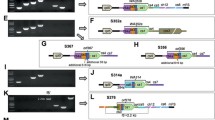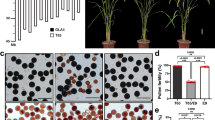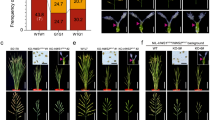Abstract
Loss of function of duplicated genes plays an important role in the evolution of postzygotic reproductive isolation. The widespread occurrence of gene duplication followed by rapid loss of function of some of the duplicate gene copies suggests the independent evolution of loss-of-function alleles of duplicate genes in divergent lineages of speciation. Here, we found a novel loss-of-function allele of S27 in the Asian annual wild species Oryza nivara, designated S27-niv s, that leads to F1 pollen sterility in a cross between O. sativa and O. nivara. Genetic linkage analysis and complementation analysis demonstrated that S27-niv s lies at the same locus as the previously identified S27 locus and S27-niv s is a loss-of-function allele of S27. S27-niv s is composed of two tandem mitochondrial ribosomal protein L27 genes (mtRPL27a and mtRPL27b), both of which are inactive. The coding and promoter regions of S27-niv s showed a number of nucleotide differences from the functional S27-T65 + allele. The structure of S27-niv s is different from that of a previously identified null S27 allele, S27-glum s, in the South American wild rice species O. glumaepatula, in which mtRPL27a and mtRPL27b are absent. These results show that the mechanisms for loss-of-function of S27-niv s and S27-glum s are different. Our results provide experimental evidence that different types of loss-of-function alleles are distributed in geographically and phylogenetically isolated species and represent a potential mechanism for postzygotic isolation in divergent species.





Similar content being viewed by others
References
Allard RW (1956) Formulas and tables to facilitate the calculation of recombination values in heredity. Hilgardia 24:235–278
Bikard D, Patel D, Mette CL, Giorgi V, Camilleri C, Bennett MJ, Loudet O (2009) Divergent evolution of duplicate genes leads to genetic incompatibilities within A. thaliana. Science 323:623–626
Chang MT, Neuffer MG (1989) Maize microsporogenesis. Genome 32:232–244
Chen J, Ding J, Ouyang Y, Du H, Yang J, Cheng K, Zhao J, Qiu S, Zhang X, Yao J, Liu K, Wang L, Xu C, Li X, Xue Y, Xia M, Ji Q, Lu J, Xu M, Zhang Q (2008) A triallelic system of S5 is a major regulator of the reproductive barrier and compatibility of indica–japonica hybrids in rice. Proc Natl Acad Sci USA 105:11436–11441
Coyne JA, Orr HA (2004) Speciation. Sinauer Associates, Sunderland, MA
Dellaporta SL, Wood J, Hicks JB (1983) A plant DNA minipreparation: Version II. Plant Mol Biol Rep 1:19–21
Doi K, Yasui H, Yoshimura A (2008) Genetic variation in rice. Curr Opin Plant Biol 11:144–148
Fuse T, Sasaki T, Yano M (2001) Ti-plasmid vectors useful for functional analysis of rice genes. Plant Biotechnol 18:219–222
Heslop-Harrison J, Heslop-Harrison Y (1970) Evaluation of pollen viability by enzymatically induced fluorescence; intercellular hydrolysis of fluorescein diacetate. Strain Tech 45:115–120
Hiei Y, Ohta S, Komari T, Kumashiro T (1994) Efficient transformation of rice (Oryza sativa L.) mediated by Agrobacterium and sequence analysis of the boundaries of the T-DNA. Plant J 6:271–282
Khush GS (1997) Origin, dispersal, cultivation and variation of rice. Plant Mol Biol 35:25–34
Koide Y, Onishi K, Kanazawa A, Sano Y (2008) Genetics of speciation in rice. In: Hirano H-Y, Hirai A, Sano Y, Sasaki T (eds) Rice biology in the genomics era, biotechnology in agriculture and forestry 62. Springer, Berlin, pp 247–259
Kosambi D (1944) The estimation of map distance from recombination values. Ann Eugen 12:172–175
Long Y, Zhao L, Niu B, Su J, Wu H, Chen Y, Zhang Q, Guo J, Zhuang C, Mei M, Xia J, Wang L, Wu H, Liu YG (2008) Hybrid male sterility in rice controlled by interaction between divergent alleles of two adjacent genes. Proc Natl Acad Sci USA 105:18871–18876
Lynch M, Conery JS (2000) The evolutionary fate and consequences of duplicate genes. Science 290:1151–1155
Lynch M, Force AG (2000) The origin of interspecific genomic incompatibility via gene duplication. Am Nat 156:590–605
McCouch SR, Teytelman L, Xu Y, Lobos KB, Clare K, Walton M, Fu B, Maghirang R, Li Z, Xing Y, Zhang Q, Kono I, Yano M, Fjellstrom R, DeClerck G, Schneider D, Cartinhour S, Ware D, Stein L (2002) Development and mapping of 2240 new SSR markers for rice (Oryza sativa L.). DNA Res 9:199–207
Moore RC, Purugganan MD (2005) The evolutionary dynamics of plant duplicate genes. Curr Opin Plant Biol 8:122–128
Oka HI (1988) Functions and genetic basis of reproductive barriers. In: Origin of cultivated rice. Japan Scientific Societies Press/Elsevier, Tokyo, pp 181–209
Paterson AH, Bowers JE, Chapman BA (2004) Ancient polyploidization predating divergence of the cereals, and its consequences for comparative genomics. Proc Natl Acad Sci USA 101:9903–9908
Rieseberg LH, Willis JH (2007) Plant speciation. Science 317:910–914
Sun S, Ting C-T, Wu C-I (2004) The normal function of a speciation gene, Odysseus, and its hybrid sterility effect. Science 305:81–83
Ueda M, Arimura S, Yamamoto MP, Takaiwa F, Tsutsumi N, Kadowaki K (2006) Promoter shuffling at a nuclear gene for mitochondrial RPL27. Involvement of interchromosome and subsequent intrachromosome recombinations. Plant Physiol 141:702–710
Win KT, Kubo T, Miyazaki Y, Doi K, Yamagata Y, Yoshimura A (2009) Identification of two loci causing F1 pollen sterility in inter- and intraspecific crosses of rice. Breed Sci 59:411–418
Yamagata Y, Yamamoto E, Aya K, Win KT, Doi K, Sobrizal, Ito T, Kanamori H, Wu J, Matsumoto T, Matsuoka M, Ashikari M, Yoshimura A (2010) Mitochondrial gene in the nuclear genome induces reproductive barrier in rice. Proc Natl Acad Sci USA 107:1494–1499
Acknowledgments
This work was supported by a grant from the Ministry of Agriculture, Forestry and Fisheries of Japan (Genomics for Agricultural Innovation, QTL-5002).
Author information
Authors and Affiliations
Corresponding author
Additional information
Communicated by E. Guiderdoni.
Electronic supplementary material
Below is the link to the electronic supplementary material.
Rights and permissions
About this article
Cite this article
Win, K.T., Yamagata, Y., Miyazaki, Y. et al. Independent evolution of a new allele of F1 pollen sterility gene S27 encoding mitochondrial ribosomal protein L27 in Oryza nivara . Theor Appl Genet 122, 385–394 (2011). https://doi.org/10.1007/s00122-010-1454-y
Received:
Accepted:
Published:
Issue Date:
DOI: https://doi.org/10.1007/s00122-010-1454-y




